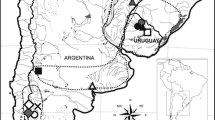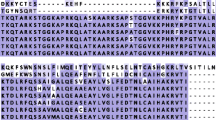Abstract
The species- and genus-specific DNA content, average base composition of nuclear DNA, presence or absence of satellite DNA, the percentage of heterochromatin and other characteristics of nuclear DNA and nuclear structure allow to deduce the molecular changes which accompanied, or more probably caused, cladogenesis in the orchids studied. It is suggested that saltatory replication (generative amplification) of certain DNA sequenes, diversification of reiterated DNA sequences, and loss of DNA play an important role in the evolution of orchids.—The relationship between changes of genome composition and of nuclear structure and ultrastructure is discussed on the basis of cot curves, heterochromatin staining with Giemsa (C banding), electron microscopy of nuclei, and molecular hybridization in situ.
Similar content being viewed by others
References
Arnason, U., Pero, R., Lima-de-Faria, A., 1976: Analysis of cetacean DNA. — Hereditas84, 221–224.
Arrighi, F. E., Hsu, T. C., Pathak, S., Sawada, H., 1974: The sex chromosomes of the Chinese hamster: constitutive heterochromatin deficient in repetitive DNA sequences. — Cytogenet. Cell Genet.13, 268–274.
Ayala, F. J. (Ed.), 1976: Molecular Evolution. — Sunderland (Mass., U.S.A.): Sinauer.
Bachmann, K., Price, H. J., 1977: Repetitive DNA inCichoriae (Compositae). — Chromosoma61, 267–275.
Barlow, P. W., in press: Determinants of nuclear chromatin structure in Angiosperms. — Annal. Sci. Nat.: Bot. Biol. végét.
Bennett, M. D., 1973: Nuclear characters in plants. — Brookhaven Symp. Biol.25, 344–366.
Beridze, T., 1972: DNA nuclear satellites of the genusPhaseolus. — Biochim. Biophys. Acta262, 393–396.
Britten, R. J., Davidson, E. H., 1969: Gene regulation for higher cells: a theory.—Science165, 349–357.
, 1971: Repetitive and non-repetitive DNA sequences and a speculation on the origins of evolutionary novelty. — Quart. Rev. Biol.46, 111–138.
, 1968: Repeated sequences in DNA. — Science161, 529–540.
Capesius, I., 1976: Isolation and characterization of native AT-rich satellite DNA from nuclei of the orchidCymbidium.—FEBS Letters68, 255–258.
, 1977: Isolation of nuclei from protoplasts of orchids. Cytobiologie15, 485–490.
Capesius, I., Bierweiler, B., Bachmann, K., Rücker, W., Nagl, W., 1975: An AT-rich satellite DNA in a monocotyledonous plant,Cymbidium. — Biochim. Biophys. Acta395, 67–73.
Eckhardt, R. A., Gall, J. G., 1971: Satellite DNA associated with heterochromatin inRhynchosciara. — Chromosoma32, 407–427.
Ehrendorfer, F., 1976: Evolutionary significance of chromosomal differentiation patterns in gymnosperms and primitive angiosperms. — InBeck, C. B. (Ed.): Origin and Early Evolution of Angiosperms, pp. 220–240. New York: Columbia University Press.
Fincham, J. R. S., Sastry, G. R. K., 1974: Controlling elements in maize. — Ann. Rev. Genet.8, 15–50.
Flavell, R. B., Rimpau, J., Smith, D. B., in press: Repeated sequence DNA relationships in four cereal genomes. — Chromosoma.
Gaddipati, J. P. B., 1976: Characterization of chromosomal DNA in higher plants with varying genome size. — Ph. D. Thesis, Banaras Hindu University, India.
Gall, J. G., Pardue, M. L., 1971: Methods in Enzymology. Vol.XXI D, 470–480, New York & London: Academic Press.
Galau, G. A., Chamberlin, M. E., Hough, B. R., Britten, R. J., Davidson, E. H., 1976: Evolution of repetitive and nonrepetitive DNA.—InAyala, F. J. (Ed.): Molecular Evolution, pp. 200–224. Sunderland (Mass., U.S.A.): Sinauer.
Gottschalk, W., 1976: Die Bedeutung der Polyploidie für die Evolution der Pflanzen. — Stuttgart: G. Fischer.
Grant, W. F., 1976: The evolution of karyotype and polyploidy in arboreal plants. — Taxon25, 75–84.
Hatch, F. T., Bodner, A. J., Mazrimas, J. A., Moore, D. H., III., 1976: Satellite DNA and cytogenetic evolution. DNA quantity, satellite DNA and karyotypic variations in kangaroo rats (genusDipodomys). — Chromosoma58, 115–168.
Hinegardner, R., 1976: Evolution of genome size. InAyala, F. J. (Ed.): Molecular Evolution, pp. 179–199. Sunderland (Mass., U.S.A.): Sinauer.
Ingle, J., Timmis, J. N., Sinclair, J., 1975: The relationship between satellite DNA, rRNA gene redundancy, and genome size. — Pl. Physiol.55, 496–501.
Jones, K. W., 1973: The method of in situ hybridization. InPain, R. H., Smith, B. J. (Eds.): New Techniques in Biophysics and Cell Biology, vol.1, pp. 29–66. London: J. Wiley.
, 1976: Repetitive DNA sequences in animals, particularly primates. — Chromosomes Today5, 305–313.
Jones, R. N., 1976: Genome organization in higher plants. — Chromosomes Today5, 117–130.
Lafontaine, J. G., 1974: Ultrastructural organization of plant cell nuclei. — InBusch, H. (Ed.): The Nucleus, vol.1, pp. 149–185. New York: Academic Press.
Lima-de-Faria, A., 1975: The relation between chromomeres, replicons, operons, transcription units, genes, viruses, and palindromes.—Hereditas81, 249–284.
, 1976: The chromosome field. V. The distribution of chromomere gradients in relation to kinetochore and telomeres. — Hereditas84, 19–34.
Macgregor, H. C., Mizuno, S., Vlad, M., 1976: Chromosomes and DNA sequences in salamanders. — Chromosomes Today5, 331–339.
Mayfield, J. E., 1977: A comparison of the differential DNA melting profiles with the CsCl density profiles of DNA fromE. coli, cow, mouse, rat and chicken. — Biochim. Biophys. Acta477, 97–101.
Nagl, W., 1972: Evidence of DNA amplification in the orchidCymbidium in vitro. — Cytobios5, 145–154.
, 1974: DNA synthesis in tissue and cell cultures. — InStreet, H. E. (Ed.): Tissue Culture and Plant Science 1974, pp. 19–42, New York: Academic Press.
, 1976: Zellkern und Zellzyklen. — Stuttgart: Ulmer.
, 1977a: Localization of amplified DNA in nuclei of the orchidCymbidium by in situ hybridization. — Experientia33, 1040–1041.
, 1977b: Early and late replication in respectively condensed and decondensed heterochromatin ofAllium carinatum. — Protoplasma91, 389–407.
, 1977c: The DNA optimization model for speciation and cytodifferentiation.—Chromosomes Today6, 151–152.
- in press: Endopolyploidy and Polyteny in Differentiation and Evolution. Towards an Understanding of Phylogenetic and Ontogenetic Variation in Nuclear DNA.—Amsterdam: Elsevier/North-Holland Biomedical Press.
-Capesius, I.: Molecular and cytological characteristics of nuclear DNA and chromatin for angiosperm systematics: Basic data forHelianthus annuus (Asteraceae).—Pl. Syst. Evol.126, 221–237.
, 1977: Repetitive DNA and heterochromatin as factors of karyotype evolution in the phylogeny and ontogeny of orchids. — Chromosomes Today6, 141–150.
, 1976: Effects of phytohormones on thermal denaturation profiles ofCymbidium DNA: Indication of differential DNA replication. — Nucl. Ac. Res.3, 2033–2039.
, 1972: DNA amplification inCymbidium protocorms, as it relates to cytodifferentiation and hormone treatment. — Cell Diff.1, 229–237.
Narayan, R. K. J., Rees, H., 1976: Nuclear DNA variation inLathyrus. — Chromosoma54, 141–154.
Schweizer, D., Ehrendorfer, F., 1976: Giemsa banded karyotypes, systematics, and evolution inAnacyclus (Asteraceae-Anthemideae). — Pl. Syst. Evol.126, 107–148.
, 1976: Heterochromatin diversity inCymbidium and its relationship to differential DNA replication.—Exptl. Cell Res.98, 411–423.
Smith, D. B., Flavell, R. B., 1974: The relatedness and evolution of repeated nucleotide sequences in the genomes of someGramineae species. — Biochem. Genet.12, 243–256.
Steffensen, D. M., Wimber, D. E., 1972: Hybridization of nucleic acids to chromosomes. InUrsprung, H. (Ed.): Nucleic Acid Hybridization in the Study of Cell Differentiation, pp. 47–63. Berlin: Springer.
Tanaka, R., 1971: Types of resting nuclei inOrchidaceae. — Bot. Mag. (Tokyo)84, 118–122.
Timmis, J. N., Deumling, B., Ingle, J., 1975: Localization of satellite DNA sequences in nuclei and chromosomes of two plants. — Nature257, 152–155.
Wilson, A. C., 1976: Gene regulation in evolution. — InAyala, F. J. (Ed.): Molecular Evolution, pp. 225–234. Sunderland (Mass., U.S.A.): Sinauer.
Zimmer, K., Koch, L., 1971: Untersuchungen zur Meristem-Vermehrung vonCymbidium sp. — Orchidee2, 49–55.
Zuckerkandl, E., 1976: Gene control in eukaryotes and the C-value paradox: “Excess” DNA as an impediment to transcription of coding sequences. — J. Mol. Evol.9, 73–104.
Author information
Authors and Affiliations
Rights and permissions
About this article
Cite this article
Capesius, I., Nagl, W. Molecular and cytological characteristics of nuclear DNA and chromatin for angiosperm systematics: DNA diversification in the evolution of four orchids. Pl Syst Evol 129, 143–166 (1978). https://doi.org/10.1007/BF00990757
Received:
Issue Date:
DOI: https://doi.org/10.1007/BF00990757




